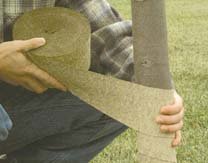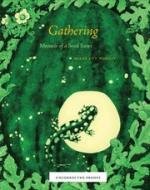

|
Bonide Tree and Shrub Food - 4 lb The Bonide Tree and Shrub Food (4 lb) is made with sulfur, sulpo mag, blood, bone and feather meal, SOP and pasteurized manures. The slow release of nutrients creates a healthy acidic environment for acid loving plants to thrive. It promotes lush foliage, rich colors, and abundant blooms of rhododendron, azalea, camellia, orchids, ferns, evergreens, dogwood, hydrangeas, andromeda, magnolias and more. Bonide Tree and Shrub Food is an all organic plant food for acid-loving plants. Apply one cup per plant; reapply every 3 months; water-in well after application. Nutrient analysis of 4% nitrogen, 6% phosphorous and 4% potassium.
|
Vinyl Tree Wrap - 36 inches About the Vinyl Tree Wrap - 36 inches: The Vinyl Tree Wrap - 36 inches is 1.5 inches in diameter and 36 inches long. The tree guard has tough vinyl spiral construction for quick and easy installation. There are holes punched in material to allow for air and moisture circulation. The tree wrap can be easily cut to make short lengths.
|
|
Multi-Fruited Apple Tree 1 FUJI, GALA, MUTSU AND JONAGOLD APPLES ALL ON THE SAME TREE!! These Multi-Budded apples are low chill semi dwarf Apple Combos on Rootstock M11. Included are the Fuji, Gala, Mutsu, and Jonagold. Always plant the smallest limb (the "weakest" bud) to the south/southwest to insure that it gets plenty of sun. Cut back the strongest growing varieties by two thirds. Cut back the weakest variety by one half, or not at all. Do not let one variety takes over, or one (or more!) of the others may fail. Prune back the more aggressive limbs. Summer-prune when necessary in order to let sunlight get to all the developing varieties. After the third season, maintain the multi-budded tree so that each fruit-type grows in balance with the others. A multi-budded fruit tree will produce more variety and a longer harvest from a limited space.
|
Multi-Fruited Pluot Tree 1 These Multi-Budded pluots are on Citation Rootstock. Included are Flavor Supreme and Dapple Dandy Multi-Budded. Always plant the smallest limb (the "weakest" bud) to the south/southwest to insure that it gets plenty of sun. Cut back the strongest growing varieties by two thirds. Cut back the weakest variety by one half, or not at all. Do not let one variety takes over, or one (or more!) of the others may fail. Prune back the more aggressive limbs. Summer-prune when necessary in order to let sunlight get to all the developing varieties. After the third season, maintain the multi-budded tree so that each fruit-type grows in balance with the others. A multi-budded fruit tree will produce more variety and a longer harvest from a limited space.
|
|
Multi-Fruited Pear Tree 1 COMICE, D'ANJOU, BARTLETT AND BOSC PEARS ALL ON THE SAME TREE!! These Multilbudded pear trees are on OHxF333 Rootstock. Included are: Comice, D'Anjou, Bartlett and Bosc Multi-Budded. Always plant the smallest limb (the "weakest" bud) to the south/southwest to insure that it gets plenty of sun. Cut back the strongest growing varieties by two thirds. Cut back the weakest variety by one half, or not at all. Do not let one variety takes over, or one (or more!) of the others may fail. Prune back the more aggressive limbs. Summer-prune when necessary in order to let sunlight get to all the developing varieties. After the third season, maintain the multi-budded tree so that each fruit-type grows in balance with the others. A multi-budded fruit tree will produce more variety and a longer harvest from a limited space.
|
 Crinkle Paper Tree Wrap About the Crinkle Paper Tree Wrap: The tree wrap is crinkled to 33 1/3% stretch and is 4 inches wide. There is 150 feet per roll.
|
|
Multi-Fruited Pear Tree 2 WARREN, KIEFFER, HARROW DELIGHT AND BLAKE'S PRIDE PEARS ALL ON THE SAME TREE!! These Multi-Budded pears are on OHxF333 Rootstock. Included are the Warren, Kieffer, Harrow Delight and Blakes Pride Multi-Budded. Always plant the smallest limb (the "weakest" bud) to the south/southwest to insure that it gets plenty of sun. Cut back the strongest growing varieties by two thirds. Cut back the weakest variety by one half, or not at all. Do not let one variety takes over, or one (or more!) of the others may fail. Prune back the more aggressive limbs. Summer-prune when necessary in order to let sunlight get to all the developing varieties. After the third season, maintain the multi-budded tree so that each fruit-type grows in balance with the others. A multi-budded fruit tree will produce more variety and a longer harvest from a limited space.
|
Multi-Fruited Cherry Tree 1 RAINIER, BING, UTAH GIANT AND VAN CHERRIES ALL ON THE SAME TREE!! These Multi-Budded cherries are on Mazzard Rootstock. Included are the Rainier, Bing, Utah Giant, and Van Multi-Budded. Always plant the smallest limb (the "weakest" bud) to the south/southwest to insure that it gets plenty of sun. Cut back the strongest growing varieties by two thirds. Cut back the weakest variety by one half, or not at all. Do not let one variety takes over, or one (or more!) of the others may fail. Prune back the more aggressive limbs. Summer-prune when necessary in order to let sunlight get to all the developing varieties. After the third season, maintain the multi-budded tree so that each fruit-type grows in balance with the others. A multi-budded fruit tree will produce more variety and a longer harvest from a limited space.
|
|
Peony - Tree - Koukamon The Tree Peony Koukamon, 'Paeonia', Deep maroon, produces a flower that is almost black towards the center. The flowers are huge, ruffled, satin-like and super hardy! Every garden needs a tree peony. There was a time, many years ago in ancient China, when the only person who could own a tree peony was the Emperor himself. We're not sure what the penalty was for infringing this law, but it can't have been very pleasant. Fortunately for us, tree peonies are now slightly more available. There are very few plants that can compete with a tree peony in full bloom. They flower from late April to early May but the flowering season does vary from year to year. A mature plant can have in excess of a hundred flowers and these can be 10" or more across! The flowers range in color from maroon, crimson, scarlet, various shades of pink, to pure white. There are also tree peonies with yellow or purple flowers. The Chinese refer to the tree peony as 'Moutan'. This has been variously translated but probably means 'The Emperor Flower'. While the tree peony originated in China, it had found its way to Japan by the 8th Century AD. Japanese tree peonies tend to have less double flowers than their Chinese peers, and the flowers are more open and delicate. Growing only 4-5' tall, these exceptional Tree Peonies are sub-zero hardy and bloom for a lifetime.
|
 Peony - Tree - Yoshino gawa The Tree Peony Yoshino gawa, 'Paeonia', produces enormous bright pale pink of rare beauty. Every garden needs a tree peony. There was a time, many years ago in ancient China, when the only person who could own a tree peony was the Emperor himself. We're not sure what the penalty was for infringing this law, but it can't have been very pleasant. Fortunately for us, tree peonies are now slightly more available. There are very few plants that can compete with a tree peony in full bloom. They flower from late April to early May but the flowering season does vary from year to year. A mature plant can have in excess of a hundred flowers and these can be 10" or more across! The flowers range in color from maroon, crimson, scarlet, various shades of pink, to pure white. There are also tree peonies with yellow or purple flowers. The Chinese refer to the tree peony as 'Moutan'. This has been variously translated but probably means 'The Emperor Flower'. While the tree peony originated in China, it had found its way to Japan by the 8th Century AD. Japanese tree peonies tend to have less double flowers than their Chinese peers, and the flowers are more open and delicate. Growing only 4-5' tall, these exceptional Tree Peonies are sub-zero hardy and bloom for a lifetime.
|
|
Peony - Tree - Kokuryu-nishiki The Tree Peony 'Kokuryu-nishiki', Paeonia suffruticosa 'Kokuryunishiki', has medium size, maroon-purple flowers with some white markings near the edges. Imported from Japan, it is a marvellous and unique variety that produces medium sized flowers. Tree peonies (Paeonia suffruiticosa) are actually shrubs, not trees. They produce woody stems and do not die back to the ground like herbaceous peonies. They are slow growing but long lived. Some specimens in China are thought to be more than 200 years old. Plants eventually grow to 3 to 5 feet tall, but they may take decades to do so. Plants prefer rich, moist, well-drained soils in partial or dappled shade. Plants bloom best in sunny sites, but flowers last longer in shady sites.
|
Peony - Tree - Kokuryu-nishiki The Tree Peony 'Kokuryu-nishiki', Paeonia suffruticosa 'Kokuryunishiki', has medium size, maroon-purple flowers with some white markings near the edges. Imported from Japan, it is a marvellous and unique variety that produces medium sized flowers. Tree peonies (Paeonia suffruiticosa) are actually shrubs, not trees. They produce woody stems and do not die back to the ground like herbaceous peonies. They are slow growing but long lived. Some specimens in China are thought to be more than 200 years old. Plants eventually grow to 3 to 5 feet tall, but they may take decades to do so. Plants prefer rich, moist, well-drained soils in partial or dappled shade. Plants bloom best in sunny sites, but flowers last longer in shady sites.
|
|
Peony - Tree - Shima-nishiki The Tree Peony Shima-nishiki, 'Paeonia', is a rare two-toned beauty that has immense red and white double flowers. They grow 4-5' tall and make ideal specimen plants. This Tree Peony has huge, ruffled, satin-like flowers that are super hardy! Every garden needs a tree peony. There was a time, many years ago in ancient China, when the only person who could own a tree peony was the Emperor himself. We're not sure what the penalty was for infringing this law, but it can't have been very pleasant. Fortunately for us, tree peonies are now slightly more available. There are very few plants that can compete with a tree peony in full bloom. A mature plant can have in excess of a hundred flowers and these can be 10" or more across! Japanese tree peonies tend to have less double flowers than their Chinese peers, and the flowers are more open and delicate. Growing only 4-5' tall, these exceptional Tree Peonies are sub-zero hardy and bloom for a lifetime.
|
Peony - Tree - Taiyo The Tree Peony Taiyo, 'Paeonia', produces bright scarlet blooms. Every garden needs a tree peony. There was a time, many years ago in ancient China, when the only person who could own a tree peony was the Emperor himself. We're not sure what the penalty was for infringing this law, but it can't have been very pleasant. Fortunately for us, tree peonies are now slightly more available. There are very few plants that can compete with a tree peony in full bloom. They flower from late April to early May but the flowering season does vary from year to year. A mature plant can have in excess of a hundred flowers and these can be 10" or more across! The flowers range in color from maroon, crimson, scarlet, various shades of pink, to pure white. There are also tree peonies with yellow or purple flowers. The Chinese refer to the tree peony as 'Moutan'. This has been variously translated but probably means 'The Emperor Flower'. While the tree peony originated in China, it had found its way to Japan by the 8th Century AD. Japanese tree peonies tend to have less double flowers than their Chinese peers, and the flowers are more open and delicate. Growing only 4-5' tall, these exceptional Tree Peonies are sub-zero hardy and bloom for a lifetime.
|
 Peony - Tree - High Noon The Tree Peony High Noon, 'Paeonia', produces a refined double flower of the brightest yellow. High noon is an excellent grower and is a free-bloomer. The huge, ruffled, satin-like flowers are magnificent and the plant is super hardy! There was a time, many years ago in ancient China, when the only person who could own a tree peony was the Emperor himself. We're not sure what the penalty was for infringing this law, but it can't have been very pleasant. Fortunately for us, tree peonies are now slightly more available. There are very few plants that can compete with a tree peony in full bloom. They flower from late April to early May but the flowering season does vary from year to year. A mature plant can have in excess of a hundred flowers and these can be 10" or more across! The flowers range in color from maroon, crimson, scarlet, various shades of pink, to pure white. There are also tree peonies with yellow or purple flowers. The Chinese refer to the tree peony as 'Moutan'. This has been variously translated but probably means 'The Emperor Flower'. While the tree peony originated in China, it had found its way to Japan by the 8th Century AD. Japanese tree peonies tend to have less double flowers than their Chinese peers, and the flowers are more open and delicate. Growing only 4-5' tall, these exceptional Tree Peonies are sub-zero hardy and bloom for a lifetime.
|
 Peony - Tree - Kamata-fuji The Tree Peony Kamata-fuji, 'Paeonia', produces full double dark pink blooms. Every garden needs a tree peony. There was a time, many years ago in ancient China, when the only person who could own a tree peony was the Emperor himself. We're not sure what the penalty was for infringing this law, but it can't have been very pleasant. Fortunately for us, tree peonies are now slightly more available. There are very few plants that can compete with a tree peony in full bloom. They flower from late April to early May but the flowering season does vary from year to year. A mature plant can have in excess of a hundred flowers and these can be 10" or more across! The flowers range in color from maroon, crimson, scarlet, various shades of pink, to pure white. There are also tree peonies with yellow or purple flowers. The Chinese refer to the tree peony as 'Moutan'. This has been variously translated but probably means 'The Emperor Flower'. While the tree peony originated in China, it had found its way to Japan by the 8th Century AD. Japanese tree peonies tend to have less double flowers than their Chinese peers, and the flowers are more open and delicate. Growing only 4-5' tall, these exceptional Tree Peonies are sub-zero hardy and bloom for a lifetime.
|
|
Peony - Tree - Kamata-nishiki The Tree Peony Kamata-nishiki, 'Paeonia', is named for the famous tapestries woven in the Kamata province. The flower is double wisteria blue with lighter edges. Every garden needs a tree peony. There was a time, many years ago in ancient China, when the only person who could own a tree peony was the Emperor himself. We're not sure what the penalty was for infringing this law, but it can't have been very pleasant. Fortunately for us, tree peonies are now slightly more available. There are very few plants that can compete with a tree peony in full bloom. A mature plant can have in excess of a hundred flowers and these can be 10" or more across! Japanese tree peonies tend to have less double flowers than their Chinese peers, and the flowers are more open and delicate. Growing only 4-5' tall, these exceptional Tree Peonies are sub-zero hardy and bloom for a lifetime.
|
Peony - Tree - Kinkaku The Tree Peony Kinkaku, 'Paeonia', produces a bloom that is full double orange yellow. These satin-like flowers are huge and ruffled and super hardy! The Rare Colorful Imperial Tree Peonies are From Japan - The Finest Quality Available! Every garden needs a tree peony. There was a time, many years ago in ancient China, when the only person who could own a tree peony was the Emperor himself. We're not sure what the penalty was for infringing this law, but it can't have been very pleasant. Fortunately for us, tree peonies are now slightly more available. There are very few plants that can compete with a tree peony in full bloom. A mature plant can have in excess of a hundred flowers and these can be 10" or more across! Japanese tree peonies tend to have less double flowers than their Chinese peers, and the flowers are more open and delicate. Growing only 4-5' tall, these exceptional Tree Peonies are sub-zero hardy and bloom for a lifetime.
|
|
Peony - Tree - Renkaku The Tree Peony Renkaku, 'Paeonia', produces a cup shaped double white flower. These huge, ruffled, satin-like flowers are super hardy! Rare Colorful Imperial Tree Peonies are from Japan - The Finest Quality Available! Every garden needs a tree peony. There was a time, many years ago in ancient China, when the only person who could own a tree peony was the Emperor himself. We're not sure what the penalty was for infringing this law, but it can't have been very pleasant. Fortunately for us, tree peonies are now slightly more available. There are very few plants that can compete with a tree peony in full bloom. They flower from late April to early May but the flowering season does vary from year to year. A mature plant can have in excess of a hundred flowers and these can be 10" or more across! The flowers range in color from maroon, crimson, scarlet, various shades of pink, to pure white. There are also tree peonies with yellow or purple flowers. The Chinese refer to the tree peony as 'Moutan'. This has been variously translated but probably means 'The Emperor Flower'. While the tree peony originated in China, it had found its way to Japan by the 8th Century AD. Japanese tree peonies tend to have less double flowers than their Chinese peers, and the flowers are more open and delicate. Growing only 4-5' tall, these exceptional Tree Peonies are sub-zero hardy and bloom for a lifetime.
|
Fertilizer Stakes - Trees About the Ross Fertilizer Stakes - trees: Ross specially packs stakes in a big 40-Pak box. One application usually lasts all year. A 15-7-6 formula specifically for mature trees and shrubs.
|
|
Fertilizer Stakes - Fruit Trees About the Ross Fertilizer Stakes - fruit trees: Ross specially packs stakes in a big 40-Pak box. One application usually lasts all year. A 8-16-16 formula specifically for fruit and ornamental trees.
|
Sargents Crabtree - White Sargents Crabtree - White, 'Malus sargentii White, is a dwarf form of M. sargentii reaching 5' in height and equal width often grafted on a 5' standard to form a specimen patio tree, or one that could be planted in a bed with foundation plants. It is known for its stunning flowers. The fragrant flowers bloom profusely in the spring, opening from the bud red in color and gradually fading through pink to white. This dwarf flowering tree is perfect for a wildlife garden, as its dark red berries are edible. The summer foliage of this deciduous tree is a dark green color. They can be planted as a specimen or patio tree, and have moderate water requirements and a moderate tolerance to salt and alkaline soils.
|
|
Sargents Crabtree - White Sargents Crabtree - White, 'Malus sargentii White, is a dwarf form of M. sargentii reaching 5' in height and equal width often grafted on a 5' standard to form a specimen patio tree, or one that could be planted in a bed with foundation plants. It is known for its stunning flowers. The fragrant flowers bloom profusely in the spring, opening from the bud red in color and gradually fading through pink to white. This dwarf flowering tree is perfect for a wildlife garden, as its dark red berries are edible. The summer foliage of this deciduous tree is a dark green color. They can be planted as a specimen or patio tree, and have moderate water requirements and a moderate tolerance to salt and alkaline soils.
|
Japanese Tree Lilac The Japanese Tree Lilac, Syringa reticulata, is a handsome, multi-stemmed, tree or large shrub that bears large creamy white flowers in large panicles in June and July. This is a clump form and will have multiple stems. Reddish-brown, cherry-like bark, and clean, dark green leaves enhance seasonal interest. Japanese Tree Lilac has spreading branches, developing a somewhat oval-rounded to vase-shaped crown. 2002 Iowa Tree of the Year. Lilacs need at least 6 hours of direct sunlight per day to produce flower buds. Too much nitrogen can lead to lush green foliage and fewer flower buds. Lawn fertilizer contains nitrogen, so avoid using it around the base of the lilac tree. Prune immediately after flowering to avoid removing flower buds. Water routinely to maintain a healthy and beautiful plant. Tree lilacs are dependable urban trees, including as parking lot or boulevard plantings, which tolerate a wide range of conditions.
|


 The food industry's digusting secrets exposed. How to protect yourself.
Click Here!
The food industry's digusting secrets exposed. How to protect yourself.
Click Here!
Discover how to easily build an attractive and affordable greenhouse that will grow anything in any conditions. Also, building your own greenhouse just makes economical sense. You can build a greenhouse at just a fraction of the cost of buying a pre-built one. Most pre-built greenhouse you buy need to be assembled anyway, you are really just paying hugely inflated prices for the material.

Daughter of Iowa farmers, Missouri homesteader, and mother of five, Diane Ott Whealy never anticipated that one day she would become a leader in a grass-roots movement to preserve our agricultural biodiversity. The love for the land and the respect for heirloom seeds that Diane shared with her husband, Kent Whealy, led to their starting Seed Savers Exchange in 1975. Read More...
